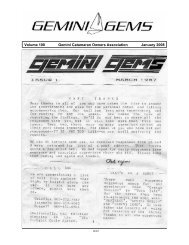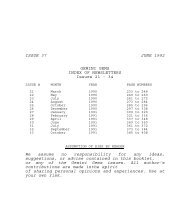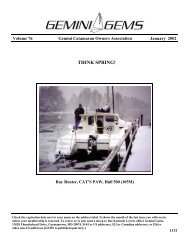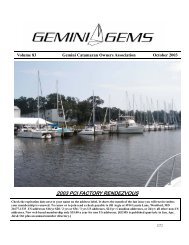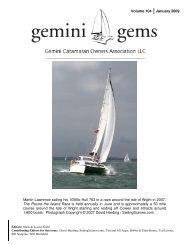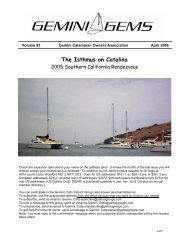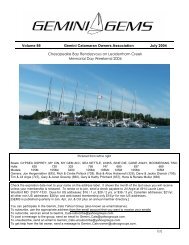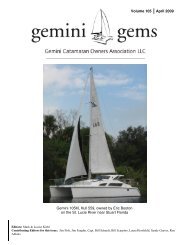Gemini Owners Manual.pub - Gemini Gems
Gemini Owners Manual.pub - Gemini Gems
Gemini Owners Manual.pub - Gemini Gems
Create successful ePaper yourself
Turn your PDF publications into a flip-book with our unique Google optimized e-Paper software.
<strong>Gemini</strong> 105Mc Owner’s <strong>Manual</strong><br />
Carbon Monoxide<br />
When propane burns with a blue flame, only carbon<br />
dioxide and water vapor are produced. However, a<br />
yellow flame is an indication that carbon monoxide<br />
is being produced. Carbon monoxide can also be<br />
produced if there is a 5% depletion of oxygen in the<br />
cabin while propane is burning.<br />
All internal combustion engines produce carbon<br />
monoxide. A gas engine is worse than a diesel engine.<br />
The largest cause of carbon monoxide poisoning<br />
is from gasoline-powered generators because<br />
they are left running for long periods of time.<br />
Propane units, if properly maintained, will not produce<br />
carbon monoxide. Proper maintenance includes<br />
keeping the system clean and maintaining<br />
good airflow. If you are at all nervous, you can try a<br />
carbon monoxide detector, but unfortunately these<br />
detectors are not 100% reliable and can be affected<br />
by atmospheric conditions. In addition, carbon monoxide<br />
detectors have to measure the time exposure<br />
as well as the amount of carbon monoxide. Thorough<br />
ventilation is the best safeguard against a<br />
build-up of carbon monoxide.<br />
Copper and Fittings<br />
The copper in use is 3/8", K type. Most of the copper<br />
fittings are connected to the various appliances with<br />
3/8" flare fittings.<br />
Checking for Leaks<br />
To check for propane leaks all the line connections<br />
should be tested. With the propane on, use a small<br />
paintbrush and liberally coat the joints with a mixture<br />
of dishwashing soap and water. A leak is identified<br />
by bubbles in the solution generated from the<br />
escaping propane.<br />
Stove<br />
The stove is an English unit with 2 burners, a broiler,<br />
and an oven. The unit includes a flame failure device<br />
to each burner so that if the flame were to blow out,<br />
after about 10 seconds the heat sensor beside each<br />
burner will cool down and the propane will automatically<br />
cut off.<br />
To light each unit there is a flame failure override<br />
procedure. In the case of the stove turning the knob<br />
counterclockwise to full “ON” and pressing the knob<br />
in allows propane to flow. Light the propane and<br />
hold the knob in for a few seconds This warms up the<br />
heat sensor and the unit will continue to run. Completely<br />
turning the knob counterclockwise turns the<br />
flame up. To turn the flame down or off, turn the<br />
knob clockwise.<br />
Refrigerator<br />
Oven Setting<br />
Propane System<br />
The refrigerator provides 4 cubic feet of storage<br />
space and a freezer compartment in the top. The<br />
refrigerator is completely silent when operating. The<br />
refrigerant uses ammonia, water and hydrogen and<br />
operates through an absorption process. The application<br />
of heat acts like a pump and starts the process.<br />
Heat applied by a small propane flame or an electric<br />
heating probe boils ammonia out of the solution of<br />
ammonia and water. Air circulating over the fins of<br />
the condenser removes heat from the ammonia vapor<br />
to cause it to condense to liquid ammonia from<br />
where it flows into the evaporator. After taking heat<br />
from the refrigerator, the ammonia returns to the<br />
reservoir near the bottom of the refrigerator, remixing<br />
with the water.<br />
This system is especially suitable to the <strong>Gemini</strong> as<br />
there is minimal heeling so the reservoir stays at the<br />
same level as the point where the ammonia is boiled<br />
out of the solution. With excessive heeling, the ammonia<br />
would not cycle through the system. This<br />
type of unit is very reliable and efficient. Any failure<br />
is normally associated with switches or the thermostat.<br />
Running the Refrigerator<br />
Fahrenheit<br />
1 230º<br />
2 266º<br />
3 302º<br />
4 338º<br />
5 374º<br />
6 410º<br />
7 446º<br />
8 482º<br />
Press the AUTO button to the “Down” position which<br />
illuminates the “Auto” light indicator. If shore power<br />
is available, the unit will select A/C operation. If<br />
shore power is not available, the unit will automatically<br />
switch to propane operation. Within 45 seconds,<br />
the burner should ignite and operate normally.<br />
If the “Check” indicator light comes on, the control<br />
has failed to light the burner on propane. To reset<br />
when the “Check” light comes on, press the main<br />
power button to the “Off” position and then “On”<br />
again which re-initiates the automatic lighting procedure.<br />
On the initial start-up, after switching propane bottles,<br />
or if the refrigerator has not been used in a<br />
Copyright © 2004 Performance Cruising Inc.<br />
13



